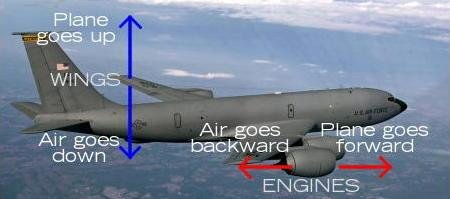Have you ever looked out of an airplane window (if you are lucky enough to have a window seat) and wondered, if a plane can fly that high, what is stopping it from carrying on and flying into Space? You are not alone. Why do planes seem to be at roughly the same altitude each time? Why can't we fly them into Space?

How does a plane fly?
To begin to answer these questions, we must first understand how a plane flies. To understand how a plane flies we must understand what the plane engines and wings do to help it take off.
Plane Engines
A plane's engines are designed and manufactured to provide a large driving force so that it pushes the plane forwards at high speeds. This can be felt when taking off; as the plane takes its place on the runway and begins to move, you can feel the speed build up very fast before you are soon in the air. The faster the plane goes is due to the engine doing more work to push the plane forward; this in turn causes more air to go through the engine, which is pushed back towards the plane wings.
Plane Wings
A plane's wings are designed so that air travels faster over them than under. When air from the engines is pushed back, air travels over the wings. Since the air is travelling faster along the top, it is forced towards the ground due to the design of the wings, which forces the plane up. Essentially, the air that is being forced DOWN is providing a force acting UP which causes the plane to take flight. This upwards force is known as lift.
Conclusion
The plane's engines provide the driving force which pushes it forward by pushing air backwards. As a result, the wings produce lift. This lift comes from the air being thrown down due to the shape and design of the wings.

So why can't we fly a plane into Space?
To make our plane fly higher, the engine must do more work to increase its speed. This increase in speed would cause the wings to generate more lift thus, getting higher. Same applies for if the engine speed decreases; the plane slows down and the lift is not enough to support the weight of the plane, so it heads back down to the ground.
As you go higher into the atmosphere, air becomes more sparse - in other words, less dense. This means the engine has to do even more work for the air to provide enough lift to further increase the altitude of the plane. Eventually many problems can arise:
Lack of Oxygen
The lack of Oxygen can cause the engine to stop working. Oxygen is required to burn the fuel in the plane to allow for it to continue driving - just like us humans need oxygen to continue to live.
Air becomes too thin
When the air becomes so sparse and thin, lift decreases to the point where it cannot carry the weight of a plane thus causing it to fall back down to Earth.
Unstable air
Due to the air being unstable it can damage the wings or engines causing the pilot to lose control of the plane. For example the flaps on the wings; these help the plane increase or decrease lift. They can snap off due to vigorous shaking due to the unstable air, causing rapid loss of control.
Wouldn't it be nice if we could book a holiday with British Airways to visit the moon! If only it was that easy.
Please check out some of my other posts as they may end up interesting you!
Until next time, take care. Mystifact